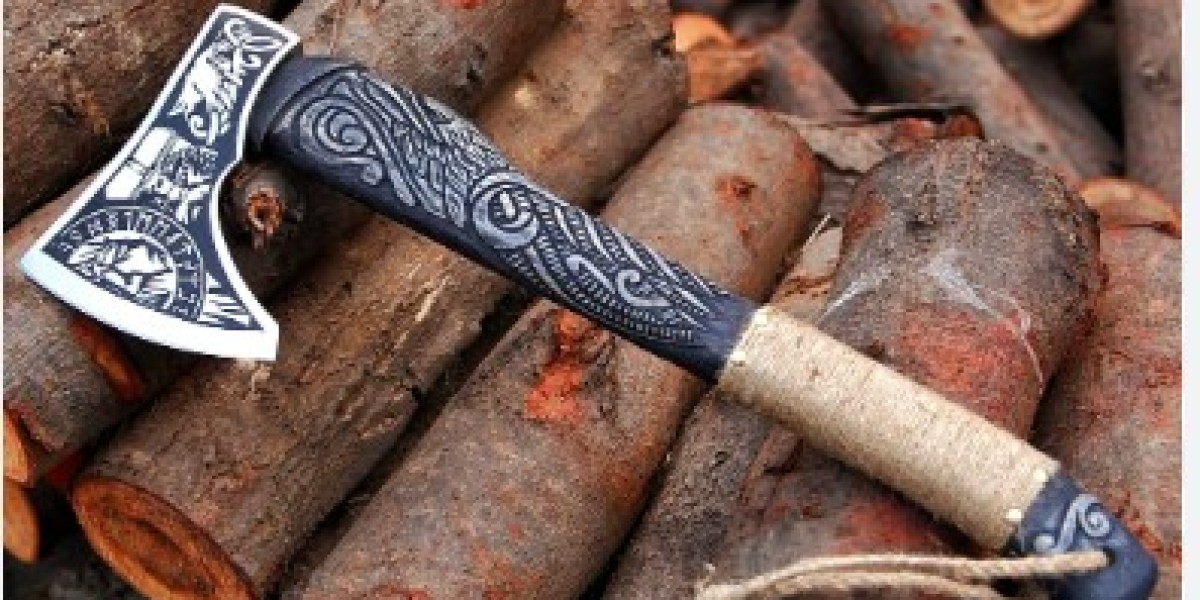The Viking Age, spanning roughly from the late 8th to the early 11th century, is often characterized by the iconic weapons and tools that defined the Norse warriors. Among these, the Viking axe stands out for its versatility, both as a weapon of war and a tool for everyday use. The production of Viking axes required not only skilled craftsmanship but also the careful selection and use of materials that were available in the Viking homelands. This article explores the various materials used in the production of Viking axes, shedding light on the ingenuity and resourcefulness of the Viking blacksmiths.
1. Iron: The Core Material
Iron was the primary material used in the production of Viking axe heads. The Vikings lived during the early medieval period, a time when ironworking had become widespread across Europe. Iron, while more challenging to work with than bronze, provided greater strength and durability, making it ideal for creating effective weapons and tools.
Viking blacksmiths typically used bog iron, a type of iron ore that could be found in the marshes and bogs of Scandinavia. Bog iron was readily accessible, and the Vikings developed efficient methods for extracting and refining it. This involved a process called smelting, where the iron ore was heated in a bloomery furnace to separate the iron from impurities. The resulting product was a spongy mass of iron known as a bloom, which was then hammered to remove slag and consolidate the metal.
2. Steel: Enhancing Durability and Sharpness
While pure iron provided the basis for many Viking axe heads, some axes were made using steel, an alloy of iron and carbon. Steel offered superior hardness and the ability to hold a sharp edge, making it highly desirable for weapons. Viking blacksmiths achieved steel production by carburizing the iron—adding carbon to it by heating iron in a carbon-rich environment, such as in charcoal fires.
Steel was typically used in the cutting edge of the axe head, a technique known as pattern welding. In this process, softer iron was combined with harder steel, creating a layered structure. The softer iron provided a resilient and shock-absorbing core, while the steel edge ensured sharpness and cutting efficiency. This method of combining materials allowed Viking axes to withstand the rigors of combat and heavy use.
3. Wood: Crafting the Axe Handle
The handle, or haft, of a Viking axes were usually made from wood, a readily available material that was both lightweight and strong. The choice of wood was crucial, as it needed to be durable enough to withstand the impact of use without breaking. Common types of wood used for Viking axe handles included:
- Ash: Known for its strength and flexibility, ash wood was a popular choice for axe handles. Its fibrous structure provided resilience, reducing the likelihood of the handle snapping under pressure. Ash also had a comfortable grip, making it ideal for long-term use.
- Oak: Another favored wood, oak was prized for its hardness and durability. It was slightly heavier than ash, which provided a different balance and feel to the axe. Oak handles could absorb shocks effectively, making them suitable for heavy-duty work.
- Hickory: Although less common in Viking territories, hickory wood was valued for its toughness and shock resistance. It would have been an ideal material if available, known for its ability to withstand repeated impacts.
Viking axe handles were often designed to be relatively long, providing greater leverage and force in both combat and woodworking tasks. The length and shape of the handle could vary depending on the type of axe and its intended use.
4. Leather: Reinforcement and Grip
While not a primary material for the axe itself, leather played a significant role in Viking axe production and use. Leather was often wrapped around the handle near the head of the axe to provide a better grip and to reinforce the area where the handle might be most likely to split. This leather wrapping also served to absorb sweat and provide a more comfortable and secure grip during use.
Leather sheaths or covers were also used to protect the axe blade when it was not in use. These sheaths prevented accidental cuts and protected the blade from the elements, which could cause rust or damage to the metal.
5. Bone and Antler: Decorative Elements
In addition to their practical functions, some Viking axes featured decorative elements made from materials like bone or antler. These materials were used to create intricate carvings or inlays on the axe handle or head, often depicting Norse mythology, runes, or personal symbols. The use of bone and antler added a personal touch to the axes, indicating the status of the owner or serving as talismans.
6. Bronze: A Legacy from the Past
Although iron and steel were the primary materials used for Viking axes, there are some historical records and archaeological findings of bronze axes. These bronze axes were likely ceremonial or status symbols, as bronze had largely been replaced by iron for practical tools and weapons by the time of the Viking Age. Bronze axes would have been less effective in combat compared to their iron counterparts but might have been used for specific ceremonial purposes or as high-status items.
Conclusion
The production of Viking axes was a testament to the skill and resourcefulness of Viking blacksmiths. By carefully selecting and combining materials such as iron, steel, wood, leather, and even bone, the Vikings created axes that were not only effective tools and weapons but also symbols of their culture and craftsmanship. The use of these materials ensured that Viking axes were durable, versatile, and capable of meeting the demands of daily life and warfare. Today, the legacy of these materials and the craftsmanship behind Viking axe for sale continue to fascinate historians, enthusiasts, and artisans alike, offering a glimpse into the ingenuity of the Norse people.









